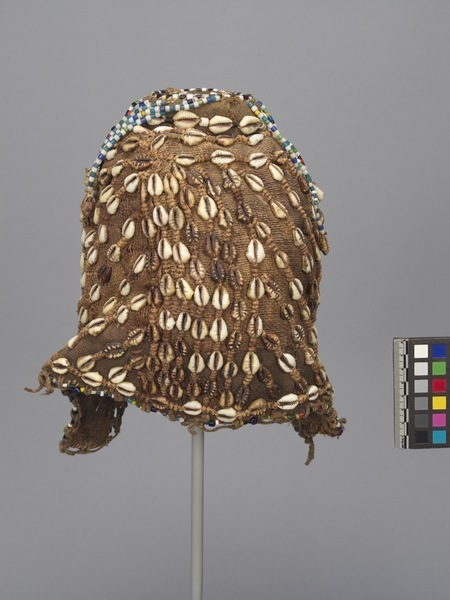Mask Item Number: 3321/8 from the MOA: University of British Columbia



Description
Female face mask. The face is carved of wood, and painted with sections of triangle designs or slanted lines. Black and white beading extends from the brow line down the ridge of the nose to the chin, with a single cowrie shell between the eyebrows. The lips are outlined in a string of beads in sections of blue and black. Attached to the mask is woven fibre, decorated with strings of cowrie shells and knotted plant fibre. A small raised form, wrapped in woven material, sits on the top of the head, with strings of various coloured beads hanging down from the form, and a cowrie shell at each end.
History Of Use
The ngady mwaash mask portrays a woman but would be worn in a performance by a man. It honours the role of women and appears in a performance about the creation of the Kuba kingdom. It would also be danced in an initiation ceremony with the bwoom (or mbwoom) mask, which personifies the king's younger brother and commoners, and the mwaash ambooy mask, the king's mask. Finally, it was worn through important funerals, being blessed by the king with ritual chants. Even back in the nineteenth century Kuba artists made masks not only for their own use but, by employing different styles, also for their neighbours. With European colonization and US exploitation, their already established production was diversified for outside markets.
Iconographic Meaning
The colours of masks are important in signifying their meaning. Red represents suffering, white means mourning and religious purity, and blue refers to high rank and the contributions of individual leaders. The characteristics of the ngady mwaash mask is shown through the boldly painted face of black and white triangles. The triangles represent hearthstones and domesticity. The lines painted on the mask represent tears, are there to evoke the importance of the mask in funerary contexts and the hardship of a woman's life.
Item History
- Made in Democratic Republic of the Congo
- Collected in Democratic Republic of the Congo during 1952
- Owned by Roxane Connick Carlisle before September 17, 2018
- Received from Roxane Connick Carlisle (Donor) on September 17, 2018
What
Who
- Culture
- Kuba
- Previous Owner
- Roxane Connick Carlisle
- Received from
- Roxane Connick Carlisle (Donor)
Where
- Holding Institution
- MOA: University of British Columbia
- Made in
- Democratic Republic of the Congo
- Collected in
- Democratic Republic of the Congo
When
- Collection Date
- during 1952
- Ownership Date
- before September 17, 2018
- Acquisition Date
- on September 17, 2018
Other
- Condition
- fair
- Accession Number
- 3321/0008